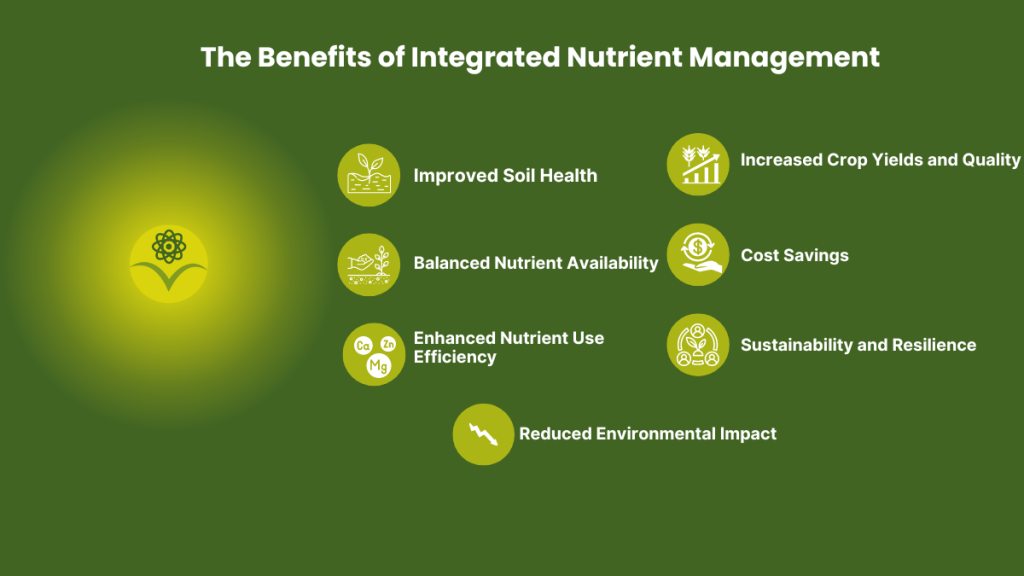Maintaining soil health & fertility is crucial for sustainable agriculture & food production. One holistic approach is through integrated nutrient management (INM).
INM is a strategic framework that combines the use of organic, inorganic, and biological nutrient sources to optimize nutrient availability, uptake, and utilization by crops.
Integrated Nutrient Management
In this comprehensive guide, we’ll explore the principles, benefits, and practical implementation of integrated nutrient management.
Whether you’re a farmer, gardener, or agricultural professional, understanding and adopting INM can help you cultivate healthier, more productive soils and crops.
What is Integrated Nutrient Management?
Integrated nutrient management (INM) is a systems-based approach to soil fertility and crop nutrition management.
It involves the coordinated use of various nutrient sources, including:
- Organic sources: Manure, compost, green manures, crop residues, and other organic amendments.
- Inorganic (synthetic) fertilizers: Nitrogen, phosphorus, potassium, and other essential mineral nutrients.
- Biological sources: Nitrogen-fixing plants, microbial inoculants, and other beneficial soil organisms.
The key principle of INM is to maintain a balance between these different nutrient sources, tailoring the application to the needs of the crops and their soil conditions.
This approach aims to:
- Optimize essential nutrient availability and uptake by crops
- Improve soil health and fertility for the long term
- Reduce reliance on synthetic fertilizers
- Minimize environmental impacts, such as nutrient leaching and greenhouse gas emissions
By integrating these diverse nutrient sources, INM seeks to create a more sustainable and resilient agricultural system.
The Benefits of INM
Adopting an integrated nutrient management approach can provide a range of benefits for farmers, gardeners, and the environment.

Let’s now explore some of its key advantages:
Improved Soil Health
Incorporating organic matter and promoting the activity of beneficial soil organisms can enhance soil structure, water-holding capacity, and overall soil health. This leads to more resilient and productive soils.
Balanced Nutrient Availability
By combining organic and inorganic nutrient sources, INM ensures a steady and balanced supply of essential nutrients for plant growth, reducing the risk of nutrient deficiencies or imbalances.
Enhanced Nutrient Use Efficiency
Integrated nutrient management can improve the efficiency with which plants utilize available nutrients, reducing the need for excessive fertilizer application and minimizing nutrient losses.
Reduced Environmental Impact
INM practices can help mitigate the environmental consequences of conventional fertilizer use, such as nitrate leaching, greenhouse gas emissions, and eutrophication of water bodies.
Increased Crop Yields and Quality
The improved soil health and balanced nutrient availability associated with INM can lead to higher crop yields, improved crop quality, and increased overall agricultural productivity.
Cost Savings
By optimizing nutrient use and reducing reliance on synthetic fertilizers, INM can help farmers and gardeners save on input costs while maintaining or even increasing their yields.
Sustainability and Resilience
Integrated nutrient management promotes a more holistic and resilient approach to agriculture, enhancing the long-term sustainability of farming systems and food production.
By understanding and implementing integrated nutrient management, you can unlock these benefits and contribute to the development of more sustainable and productive agricultural practices.
Key Principles of Integrated Nutrient Management
Integrated nutrient management is guided by several key principles that inform its effective implementation. Let’s explain these principles in more detail:

Nutrient Balancing
INM emphasizes the importance of maintaining a balanced supply of essential macro- and micronutrients (such as nitrogen, phosphorus, potassium, and various trace elements) to meet the needs of the crops and soil.
Organic Matter Management
Incorporating organic matter, through the use of compost, manure, crop residues, and green manures, helps to improve soil structure, water-holding capacity, and the activity of beneficial soil organisms.
Biological Nitrogen Fixation
Promoting the use of nitrogen-fixing plants, such as legumes, can help reduce the need for synthetic nitrogen fertilizers and contribute to the overall nitrogen balance in the system.
Soil Testing and Customized Recommendations
Regular soil testing and analysis are crucial for understanding the nutrient status and specific requirements of the soil, allowing for the development of tailored nutrient management plans.
Integrated Pest and Disease Management
INM recognizes the importance of integrating various pest and disease management strategies, including the use of biological control agents, to maintain a healthy and resilient cropping system.
Precision Nutrient Application
Careful timing, placement, and application of both organic and inorganic nutrient sources can help minimize nutrient losses and maximize their utilization by crops.
Crop Rotation and Diversification
Implementing diverse crop rotations and polyculture systems can help improve nutrient cycling, break pest and disease cycles, and enhance overall agroecosystem resilience.
Farmer Participation and Knowledge Sharing
Successful INM implementation relies on active farmer engagement, knowledge sharing, and the incorporation of traditional agricultural practices and local knowledge.
By adhering to these principles, farmers and gardeners can develop and implement integrated nutrient management strategies for the soil, climatic, and cropping system conditions.
Implementing INM
Transitioning to an integrated nutrient management approach involves a step-by-step process.
Here’s a general framework for implementing INM:

Assess the Current Situation
Begin by conducting a thorough assessment of your soil, crop, and nutrient management practices. This includes soil testing, nutrient budgeting, and evaluating the current use of organic and inorganic fertilizers.
Develop a Nutrient Management Plan
Based on the assessment, create a comprehensive nutrient management plan that outlines the optimal combination of organic, inorganic, and biological nutrient sources to meet the demands of your crops and soil.
Integrate Organic Nutrient Sources
Incorporate organic matter, such as compost, manure, crop residues, and green manures, into your soil management practices. This can help improve soil fertility, structure, and water-holding capacity.
Utilize Biological Nutrient Sources
Explore the use of nitrogen-fixing plants, microbial inoculants, and other beneficial soil organisms to enhance nutrient cycling and availability.
Optimize Inorganic Fertilizer Use
Carefully manage the application of synthetic fertilizers, ensuring that the timing, placement, and rates are aligned with the crop’s needs and the overall nutrient management plan.
Implement Precision Nutrient Application
Adopt precision farming techniques, such as variable-rate application, GPS-guided fertilizer spreaders, and soil-specific recommendations, to enhance nutrient use efficiency.
Diversify Cropping Systems
Incorporate crop rotations, intercropping, and polyculture systems to promote nutrient cycling, pest and disease management, and overall agroecosystem resilience.
Monitor and Adjust
Regularly monitor the soil, crop performance, and nutrient dynamics, and be prepared to adjust your nutrient management plan as needed to address any imbalances or changing conditions.
Engage in Knowledge Sharing
Collaborate with other farmers, extension services, and research institutions to share knowledge, learn from successful INM practices, and continuously improve your approach.
Implementing integrated nutrient management is a dynamic and ongoing process that requires a combination of scientific knowledge, practical experience, and a willingness to adapt to local conditions and evolving agricultural challenges.
Case Studies
To illustrate the real-world application of integrated nutrient management, let’s explore a few case studies:
Smallholder Farmers in Sub-Saharan Africa
In many parts of Sub-Saharan Africa, smallholder farmers have traditionally relied on a combination of organic and inorganic nutrient sources to maintain soil fertility.
By integrating the use of compost, animal manure, and nitrogen-fixing legumes with judicious application of synthetic fertilizers, these farmers have been able to improve crop yields, enhance soil health, and reduce their environmental footprint.
Rice-Wheat Cropping System in South Asia
The rice-wheat cropping system is a dominant agricultural practice in South Asia.
Researchers have worked with farmers to develop INM strategies that combine the use of organic amendments, such as green manures and rice straw, with optimized application of chemical fertilizers.
This approach has led to increased yields, improved nutrient use efficiency, and reduced greenhouse gas emissions.

Organic Vegetable Production in Europe
In Europe, many organic vegetable growers have embraced integrated nutrient management to maintain soil fertility and crop productivity.
They utilize a variety of organic sources, including compost, vermicompost, and green manures, in combination with targeted application of approved organic fertilizers and biostimulants.
This integrated approach has enabled them to achieve high-quality, nutrient-dense produce while preserving the long-term health of their soils.
Integrated Farming Systems in Brazil
In Brazil, some farmers have adopted integrated farming systems that combine crop production, livestock rearing, and aquaculture.
These systems leverage the synergies between different components to optimize nutrient cycling and minimize waste.
For example, animal manure is used to fertilize crops, while crop residues and aquaculture waste are incorporated back into the soil, creating a closed-loop nutrient management system.
These case studies demonstrate the versatility and effectiveness of integrated nutrient management in diverse agricultural contexts.
By adapting the principles and practices to their specific needs and conditions, farmers and growers can unlock the full potential of INM for sustainable and productive food production.
Conclusion: The Future of Integrated Nutrient Management
As the world faces the challenges of population growth, climate change, and the need for more sustainable agriculture, integrated nutrient management will continue to play a crucial role in shaping the future of food production.
Moving forward, we can expect to see further advancements and innovations in INM, including:
Precision Farming Technologies
The integration of precision agriculture tools, such as GPS-guided applications, drones, and sensor-based monitoring, will enable even more targeted and efficient nutrient management.
Biological Innovations
Continued research and development in the field of microbial inoculants, biological nitrogen fixation, and other cutting-edge biological approaches will enhance the capabilities of INM.
Circular Economy Principles
The incorporation of circular economy principles, where waste streams are repurposed as nutrient sources, will further strengthen the closed-loop nature of integrated nutrient management.
Integrated Pest and Disease Management
The integration of INM with comprehensive pest and disease management strategies will create more resilient and sustainable agricultural systems.
Farmer-Centric Approaches
Increased emphasis on farmer participation, knowledge sharing, and the incorporation of traditional agricultural practices will ensure that INM remains relevant and tailored to local needs.
As we embrace the principles of integrated nutrient management, we can look forward to a future of more productive, environment-friendly, and resilient agricultural systems that contribute to global food security and the long-term sustainability of our planet.
Learn more about optimizing Plant Health and Growth with Nutrition Management.
Check out the Role of Integrated Nutrient Management for Sustainable Maize Production.

